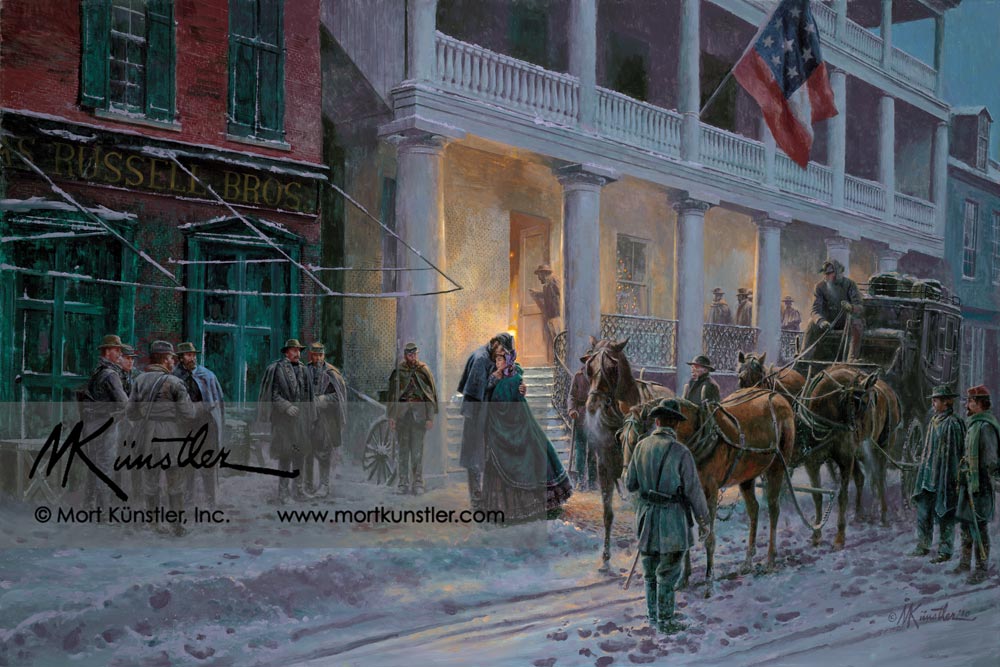The Official Mort Künstler Website
Mrs. Jackson Comes to Winchester - limited edition print
Mrs. Jackson Comes to Winchester - limited edition print
"Stonewall" and Mary Anna at the Taylor Hotel, December 23, 1862
Regular price
$350.00 USD
Regular price
Sale price
$350.00 USD
Unit price
per
Shipping calculated at checkout.
Couldn't load pickup availability
The COLLECTOR'S edition is shipped UNSTRETCHED. Stretching is available at an additional charge. Please contact us for pricing: 800-850-1776 or info@mortkunstler.com.
Custom framing is available for this print. Please call 800-850-1776 or email info@mortkunstler.com for more information.
LIMITED EDITION PRINTS
Paper Prints
Reproduction technique: Fine offset lithography on neutral pH archival quality paper using the finest fade-resistant inks.
Each print is numbered and signed by the artist and accompanied by a Certificate of Authenticity.
Image Size: 18” x 27” • Overall Size: 23” x 31”
Signed & Numbered • Edition Size: 350
Signed Artist’s Proof • Edition Size: 50
Giclée Canvas Prints
Reproduction technique: Giclées are printed with the finest archival pigmented inks on canvas.
Each print is numbered and signed by the artist and accompanied by a Certificate of Authenticity.
Signature Edition Size: 17” x 25”
Signed & Numbered • Edition Size: 50
Artist’s Proof • Edition Size: 10
Classic Edition Size: 20” x 30”
Signed & Numbered • Edition Size: 50
Artist’s Proof • Edition Size: 10
Premier Edition Size: 26” x 39”
Signed & Numbered • Edition Size: 15
Artist’s Proof • Edition Size: 5
Collector’s Edition Size: 40” x 60”
Signed & Numbered • Edition Size: 5
Artist’s Proof • Edition Size: 2
Mort Künstler’s Comments
To paint “Stonewall” Jackson and his wife Mary Anna in Winchester at night and in the snow is a major problem for me. I did Until We Meet Again more than twenty years ago and it still remains one of the most popular paintings I’ve ever done. It has exactly those same elements in it and it is of course, a tough act to follow.
However, after rereading Stonewall Jackson by Dr. James I. Robertson, Jr., the world’s foremost authority on the subject, I decided to give it another try.
The following excerpt from the book is what inspired this painting:
…Those reports were not as disturbing to Jackson as they might have been. A wonderful distraction gripped his mind: his beloved Anna was due to arrive in Winchester at any time. For weeks she had been begging to join her husband.When he seemed agreeable in mid-November, Anna packed quickly for the trip. She refused to wait for the aide Jackson had promised to send as an escort. Friends accompanied her to Richmond; “a kind-hearted but absent-minded old clergyman” traveled with her the rest of the way—even though he managed to lose Anna’s trunk in the process.
The final stagecoach ride brought Anna to Winchester late at night. She disembarked in front of the Taylor Hotel without baggage and with no one to greet her. With uncertainty she started up the hotel steps. A heavily bearded soldier stepped away from a group of people on the sidewalk and slowly walked up behind her. Powerful arms swung Anna around; kisses rained on her face. It was Jackson. He had ridden down to the hotel with the hope that the midnight stage might bring his wife.Even before the war brought armies to its door, the Taylor Hotel was one of the most popular gathering places in all of Winchester. Its two-story building shadowed main-street, standing just down the road from the town’s Greek revival courthouse and alongside solid brick shops, and quaint taverns. In May of 1862, renowned cavalryman Turner Ashby received his general’s star in a special promotion ceremony held at the Taylor. His permanent promotion was later confirmed by the Confederate Congress, shortly before he died in June. During the Second Battle of Winchester in July of 1863, the hotel was commandeered by occupying Federal forces that used it as a field headquarters. The Taylor continued to trade hands throughout the course of the conflict and managed to survive the war. Although it is no longer open, the structure is still standing and has become a beacon to architectural preservationists in the area.





